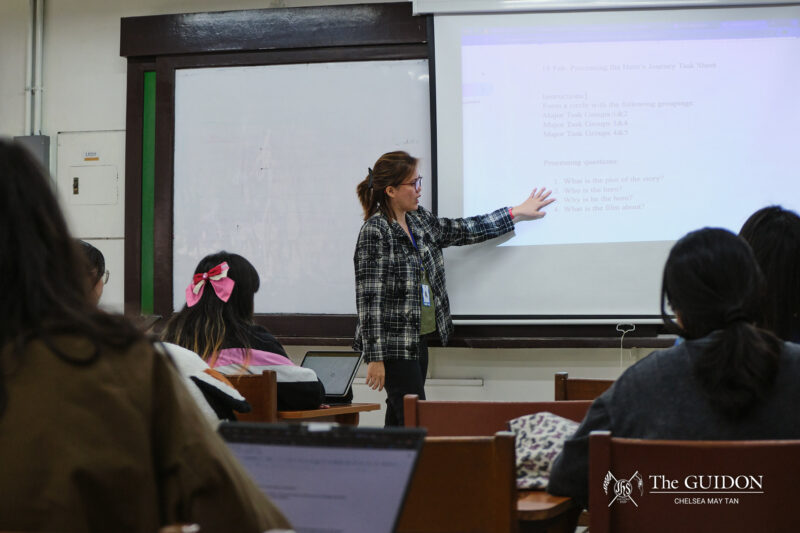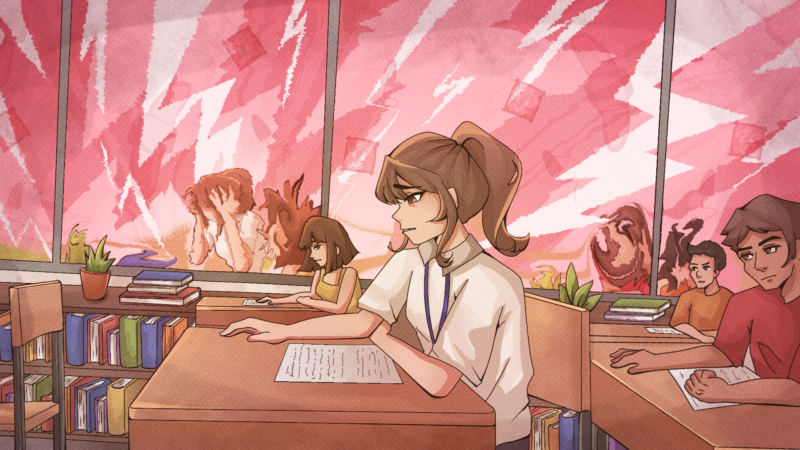Katipunan Avenue, which is a part of Circumferential Road 5 (C-5), is more than just a road leading to schools and review centers. Virtually inseparable from the Katipunan college experience, it’s also where students hang out, shop around, and even live in.
Significant as the road may be for the typical passerby, it may also pose a risk to his life. These risks include cases of theft, hit-and-run, and car accidents, the latest of which involved a six-wheeler truck that hit Bo’s Coffee Katipunan.
How safe then is Katipunan Avenue to the typical Atenean?
The battle outside
For students like Robert Beltejar (II BS LM), Katipunan traffic can be the worst nightmare. Says Beltejar, “I missed my Math finals in first year because a truck bumped into my car [as a result of the chaotic traffic].”
To address traffic problems, the Metropolitan Manila Development Authority (MMDA) has implemented new schemes. One such scheme is the removal of two U-turn slots, one near the front of Ateneo’s Gate Two and the other under the footbridge near Miriam College.
Although this new system was implemented to help reduce traffic, it caused quite a stir as the MMDA failed to inform beforehand the schools, the barangay, and the city officials. According to Loyola Heights Barangay Chairman Caesar Marquez, his office received a memo from the MMDA indicating the change of U-turn schemes. They didn’t know, however, when these changes would be implemented. Says Marquez, everyone was shocked that there were new U-turn slots.
Because of this, traffic was chaotic during the first few days of the scheme’s implementation.
Ateneans have mixed reactions regarding the new scheme. Leiron Martija (II AB-MA PoS), thinks the traffic scheme’s okay because “more U-turns mean more traffic”.
And although it has taken Mira* some time to adjust to the new scheme, she also believes that there’s nothing wrong with it. “When [the scheme] was new, it caused so much traffic,” she says in Filipino. “But now, it seems that everything’s okay.”
Others, however, have a different view. Beltejar, for instance, describes the reduction of the number of U-turns as “idiotic”. “[The U-turn is] totally inconvenient. [It’s a] waste of gas since you have to go all the way to the U-turn across La Vista,” he says.
Priscilla* agrees with Beltejar and adds, “Maybe [MMDA] can adjust it by opening up the U-turns during non-peak hours so that students [who leave in the middle of the day]…don’t have to go through the inconvenience of driving all the way to the end of the road.”
Besides the removal of U-turn slots, concrete barriers were also put in front of the campus’ Gate Two. This is to prevent Ateneo-bound vehicles coming from the flyover from cutting across other traffic lanes in order to reach the gate.
Changes like these have improved traffic a lot, says Reynaldo Saligumba, an MMDA traffic enforcer. Before the scheme was implemented, traffic from where the barriers are now would often spill over to traffic across the flyover, he says.
Stubborn motorists
Meanwhile, other factors have led to numerous accidents to occur in Katipunan. According to Saligumba, these safety hazards are especially caused by tricycle drivers who still don’t follow the new system.
According to him, some tricycles that exit from Gate 3 cut across the four lanes between the exit and the U-turn slot in front of the Miriam College gate. This results in the blocking of the vehicles behind the tricycle as well as a potential risk of colliding with other vehicles.
Even students are guilty of this practice. Jemima* confesses that she sometimes does the same thing because the U-turn slot is far from her. She says, however, that she only does this when there aren’t any cars approaching.
Leoncio Miralao Jr ,University Physical Plant administrator, adds that, when there aren’t any MMDA traffic enforcers on duty in the morning, some drivers coming from the Katipunan flyover pass through the newly installed concrete barrier in order to avoid having to take the longer detour at Gate 3. “It is risky [since] it obstructs the flow of traffic and sets a bad example to the grade school students,” he says.
Angelo Arayata (II AB-MA PoS) agrees. “We could always make the roads safer by building better and more efficient infrastructure but there are limits to that being a solution.”
He says that the real problem lies with the motorists themselves. “We have to find a way to make the drivers more efficient and more defensive when driving.”
Collision road
Accidents in the morning are comparably not as disastrous as the ones that usually occur between 5 pm and 11 pm. Says Saligumba in Filipino, the accidents that occur in the morning are usually few and aren’t that serious because cars move at a slow speed in traffic.
Accident-prone areas along Katipunan are generally found at the U-turns as well as the gates of both the Ateneo and Miriam College. The exit at Gate 2, for example, is a troublesome area since vehicles exiting the Ateneo must accurately calculate their entry into Katipunan. Miscalculations often lead to minor crashes. A major danger spot is found near the gate of Miriam, where a U-turn and an exit meet.
Problems on the side
Safety concerns and issues in the Katipunan area are not limited to the road itself. Vehicles in the parking lanes in front of Katipunan establishments are also subject to harm, chief of which is theft.
While window-breaking is not common in the area since there are many witnesses and passersby, authorities say that thieves have a different target: SUV tires. Saligumba says that groups of robbers would park next to a parked SUV and steal its spare tire. According to him, it’s because these tires are very easy to take off.
Thefts aren’t limited to the main road. Esteban Abada Street, which is behind Katipunan, is a frequent target of thieves. Guards from Esteban Abada establishments say that laptops and purses are often stolen from cars parked along the road, especially in the parts unlit or unguarded by security officers.
Marquez admits to having received many complaints from people, especially students regarding things stolen from their vehicles. He says, however, that most of these complaints never materialize since complainants would back off once the real investigation process occurs.
“Students would rather not bother with filing cases since [the hassle] would affect their academics, among other things,” he says. It then becomes more difficult for the barangay officials to track down who the thieves are and, thus, implement preventive measures.
Despite these difficulties, the barangay still makes efforts in ensuring the safety of cars parked in the establishments along Katipunan. Just recently, Barangay Ordinance 07 S-2008, which requires that parking attendants be registered with the barangay, was implemented.
“There is a need to deter crime in parking areas of these establishments,” say Marquez.
Joint efforts
Besides releasing the ordinance, the barangay hall has also tied up with the Ateneo and Miriam in organizing and preparing the cases of theft that occurred outside campus.
Preventing these thefts from happening, however, starts with the students’ efforts. Marquez says that oftentimes, students make the careless mistake of being complacent about their belongings, leaving behind laptops, bags and other gadgets inside their cars for many thieves to see.
“It’s like you’re teasing the robbers [to steal from you],” says Marquez. He especially cautions students about the current Christmas season.
“Life’s difficult. So, be more vigilant when going home,” he says in a mix of Filipino and English.
Parking in the right spots is also another measure students must constantly comply with. Many of the thefts occur in the less-populated areas where parking isn’t even allowed, according to him.
Marquez says that maintaining peace and safety in Katipunan should be everybody’s concern. It relies on the actions of everyone involved—from students and barangay officials to school administrators.
“We can’t do it alone. It should involve everybody,” he says.
*Names have been changed to protect the individuals.






